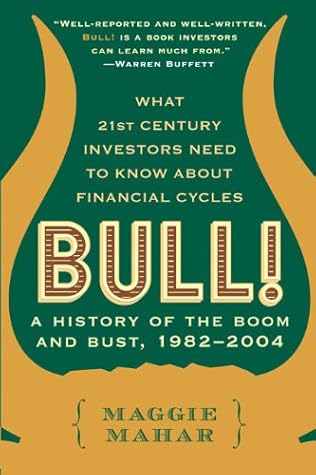More on this book
Kindle Notes & Highlights
by
Maggie Mahar
Read between
November 13 - November 16, 2020
Wall Street’s ...
This highlight has been truncated due to consecutive passage length restrictions.
No wonder “sell” recommendations were rare.
“Where was the analysis?”
On deadline, few financial journalists did their own research; many took analysts...
This highlight has been truncated due to consecutive passage length restrictions.
Merrill Lynch’s Henry Blodget
Salomon Brothers’ Jack Grubman
THE PEOPLE’S CHOICE
Buying stocks and equity funds had become an addiction, but no one had put a gun to the individual investor’s head.
New York Stock Exchange,
CNBC’s Squawk Box,
PBS interview on Media Matters
“Now, they’re looking for scapegoats, and the media is an easy scapegoat. But I’ve got bad news—it was your fault if you lost a lot of money.”
Wall $treet Week
Louis Rukeyser
BEGINNINGS (1961–89)
—3— THE STAGE IS SET (1961–81)
WARREN BUFFETT—THE EARLY YEARS
And in May of 1969, that is exactly what Warren Buffett did.
Buffett was lucky enough to set up shop in the fifties.
In those early years he managed a pool of money for a group of clients, many of them friends and acquaintances, in his hometown of Omaha, Nebraska, forming what he called the Buffett Partnership.
At the time, an older broker gave Levy some advice: “You know something, kid,” the veteran said, “you ought to buy something you really like, because when this is over, you’re not going to have anything.” Levy bought himself a Mercedes 190 SL, only slightly used, with an extra top, for $6,100. “I took his advice,” Levy, who went on to form a private money management firm, remembered years later, “and he was quite right.” In May of 1962—on a day that would go down in Wall Street history as Blue Monday—the Dow dropped 34.9 points, its largest one-day drop since 1929. “When it was all over, I had
...more
INVESTING À-GO-GO
Jim Awad
Vietnam War.
NYSE in 1967
(The Exchange responded by installing bulletproof glass around the visitor’s gallery, “thereby seeming to indicate that it considered thrown-away dollar bills to be lethal weapons,” noted New Yorker writer John Brooks in his history of the era, The Go-Go Years.)4
Youthful money managers like Awad belonged to a slightly older, more buttoned-down generation.
Brooks could just as easily have been describing the nineties when he wrote: “It was coming to be believed, in the absence of evidence to the contrary, that almost any man under forty could intuitively understand and foresee the growth of young, fast-moving unconventional companies better than almost anyone over forty.”6
Financial euphoria
summit in Februar...
This highlight has been truncated due to consecutive passage length restrictions.
WARREN BUFFETT STEPS TO THE SIDELINES
In 1967 his fund rose 36 percent—more than twice the Dow’s advance—and in 1968
Roger Lowenstein, Buffett’s biographer.
At the height of a bull market, with his own portfolio soaring, Warren Buffett was cashing in his chips.
He advised them that he was putting most of his own money into municipal bonds, while holding on to just two stocks: Diversified Retailing, a small holding company for a dress chain, and a textile company called Berkshire Hathaway. “On the one hand, he didn’t think much of textiles; on the other hand, he liked the guy in charge,” Lowenstein reported.
Warren Buffett was not the only professional investor who saw trouble ahead.
Institutional Investor
In 1969 the market was already set on a crash course that would end, four years later, in the sell-off of 1973–74—a disaster that would rival the Great Crash of 1929.
But first, the bear toyed with investors, taking them on a toboggan ride that they would never forget. After grazing 1000 in February of 1966, the Dow slid headfirst, hitting 744 in October, then turned around and headed back uphill, flirting with 1000 a second time at the very end of 1968—before plummeting once again.
Litton Industries,
Transitron
National G...
This highlight has been truncated due to consecutive passage length restrictions.
In 1970, the first major crash of the early seventies began: by May the Dow had fallen from roughly 800 to 630, and insouciance quickly gave way to fear.
1969.
1970 New York Stock Exchange
individual in...
This highlight has been truncated due to consecutive passage length restrictions.
1...
This highlight has been truncated due to consecutive passage length restrictions.
1969–1970
July 1970,
THE NIFTY FIFTY


